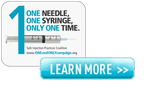
What are the next steps when your facility is ready to make a change because they are committed to patient safety? How does a facility educate their staff in the reasons for and the process of performing random drug screens on all who have access to controlled substances? What do they do when many staff threaten to quit if random drug screens are implemented? Below are some suggestions.
Excerpts taken from “Cuyuna Regional Medical Center’s Drug/Alcohol Free Workplace and Testing Policy”
Why do it (Goals):
is committed to providing high quality health care services and acknowledges the importance of each employee to the effective function of a competent health care team sees substance abuse as a very serious problem and as a threat to employees, volunteers, patients and visitors - The ultimate goal of this policy is to balance our respect for individual privacy with our need to maintain a safe, productive, drug/alcohol free work environment
is committed to maintaining a work environment free from the influence of alcohol and/or drugs and thereby protecting the health, safety and well-being of patients, employees, volunteers and visitors
Policy Details:
employees are required to immediately notify their supervisor if any member of the health care team is not in appropriate mental and/or physical condition to safely perform their duties. They should not be allowed to perform any duties - Assuming a reasonable suspicion, the employee will be escorted to the laboratory department for testing
- An individual who refuses to be tested, or whose behavior prevents completion of the testing, such as – tampering with the sample or testing materials, behavior intended to provide a dilute sample, failure to provide specimen within a reasonable amount of time (3 hours from initiation of testing) or not providing the required amount (30 cc) – will be subject to termination, other disciplinary actions, or have the employment offer revoked
- An individual has the right to refuse testing, but they must be made aware that such refusal may result in disciplinary action including termination
- For the individual’s safety, arrangements may be made for:
- Transportation: the individual will be sent home with a sober adult
- If he/she insists on driving home, city law enforcement will be notified.
- The individual will remain off work on paid leave until all drug testing results are received and confirmed
will instruct employees on the common identifying factors of drug use and diversion, some of which are: - A nurse uses the maximum PRN dosage when other nurses use less
- A nurse insists on personal administration of injected narcotics to patients
- Statements such as…“If anybody needs help passing their pain meds today let me know.”
- A patient states that pain medication was not given but documentation shows that it has been administered
- A nurse shows frequent wastage of drugs for “spillage”
- Sloppy or poor record-keeping
- A nurse’s handwriting or charting deteriorates
- Increased absenteeism is common in end-stage addiction
- Increased disappearances from the work-site or increased taking of breaks
- Increased/frequent or long trips to the bathroom
- A nurse will often appear at work when not scheduled
- Uncharacteristic confusion, memory loss, difficulty concentrating
- Deterioration of interpersonal relationships with colleagues, staff and patients
- Will not admit errors or accepts blame for mistakes or oversights
- Personality change: mood swings, anxiety, depression, lack of impulse control
- Patient and/or staff complaints about health care provider’s attitude and behavior
Many will be angry over the facility’s decision to begin random drug screens of employees with access to controlled substances. They will cry out that it is unfair; it is an invasion of their privacy; it is costly; they may even threaten to quit and some actually will quit. Let them rant, but continue to remind them that you are committed to patient and employee safety. Your goal is to minimize, even eliminate, drug diversion at your facility and this is one of the best ways to do that.
It is important to remember that the policy is being done to maximize patient and healthcare worker safety, not to punish. The policy is not to invade anyone’s privacy. Unfortunately these days, we have to be vigilant in our quest to stop drug diversion, it is pervasive and it is getting worse. Just do a Google search for drug diversion in healthcare and you’ll see so many examples of the problems that accompany diversion. There is something we can do, we can simply drug test those with access to the drugs that are most commonly diverted. We can test the syringes that are returned as waste. We can let addicts know that we are watching them and we will discover what they are doing. Most importantly, we will get them help.






Leave a comment